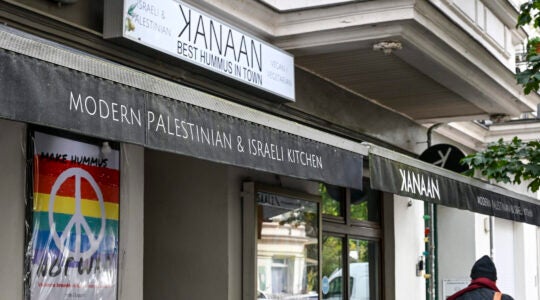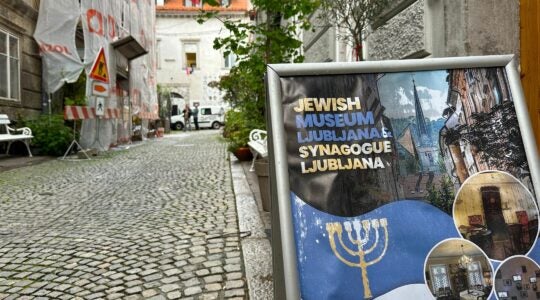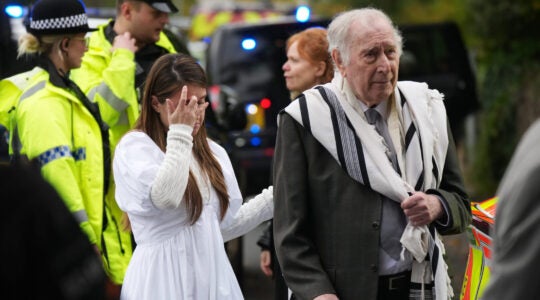
The former Orthodox synagogue in Trnava, Slovakia, has been converted into an avant-garde art gallery. (Alex Weisler)
Leave it to Slovakia to put it in perspective.
This trip has provided me with examples from the full spectrum of options for synagogues in western Slovakia — and I have to keep reminding myself that it’s all relative.
The shul in Stupava has been blessed by dedicated volunteers committed to reviving the space and creating a new, vibrant Jewish cultural center. I’ve been in Europe for more than three months now, and my Gmail account is full of projects I’ve made a mental note to check back on in a few years’ time — Stupava quickly vaulted to near the top of that list.
But the problem with something like Stupava is that you get spoiled.
At our next stop, in the dull, grey town of Malacky, I had trouble completely embracing the synagogue, which was beautifully preserved and a clear focal point of the community. Malacky’s Alhambra-inspired, salmon-striped shul is in great condition, but it’s now an art school and our trip leaders told us that much of the interior has been reconstructed for that purpose.
Rather than celebrating the comparatively good fortune of the Malacky synagogue, I found myself lamenting the fact that it is no longer an explicitly Jewish space.
Our next stop, in the town of Senec, reminded me that’s the wrong approach.
[[READMORE]]
Senec’s shul could be gorgeous, an elegant stone building overlooking a neat town square that’s an oasis from endless rows of concrete apartment blocks. Instead, the synagogue is battered and broken, shuttered and left to the birds. A Senec resident told our group leader that he’d read an article in a local newspaper about a forthcoming restoration plan, but he had no definitive proof of that, nor a timetable.
But it was our final stop of the night — in Trnava, full of churches and spires that sometime give it the nickname "Catholic Oxford" or "Slovakian Rome" — that left me the most torn up. (Or is that trn up?)
The city has two, non-active synagogues, one an Orthodox space that’s been turned into an avant-garde art gallery and the other a "status quo" shul (that’s the regional denomination that tries to hearken back to a time before a schism divided Hungarian Jewry into Orthodox and liberal factions) that’s a performance space and small museum.
The status quo synagogue is a cold, spartan space, somewhat restored but still clearly in need of a little TLC. On the inaccessible balcony that once housed the women’s section, a small museum with items on loan from the Bratislava Jewish community is primed and ready to open once some structural repairs are completed in the next month or two. The building’s facade is charred and slightly crumbling, reminders of a 1986 fire.
Just a block away is the beautifully restored Orthodox synagogue, a white building with lime-green trim that dates back to 1892. Inside, the shul’s impressive ceiling paintings — blue stars of David and complex geometric designs — are bright and vibrant. But the space now houses an art gallery that, when we visited, featured a series of odd photo-painting hybrids of nude women — wrestling dragons, riding horses, crucified. Behind a screen showing a Celine Dion-like singer on loop is the old Aron Kodesh, now covered by a painting of a bloody woman, perhaps the Virgin Mary. Wine is sold at the entrance.
It got me thinking about what strange lives all these proud, old synagogues have had. What’s better: the status quo synagogue that’s now crumbling but remains tied to its Jewish past, or the Orthodox shul that’s beautifully restored but frankly a bit sacrilegious?
To what extent does preservation include the symbolic, not just the structural?
It’s probably not my question to answer. I don’t run these towns, I don’t own these sites, and I’m not a Slovak. But it’s always good to get jolted out of previously conceived black-and-white notions.
And hey, a bloody Virgin Mary covering the Aron Kodesh will do just that.
JTA has documented Jewish history in real-time for over a century. Keep our journalism strong by joining us in supporting independent, award-winning reporting.





